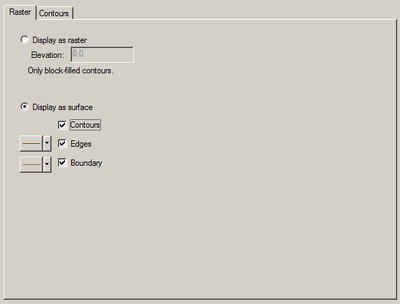Raster Options: Difference between revisions
From XMS Wiki
Jump to navigationJump to search
(Created page with 'The raster options are accessed by clicking on the Raster Options item or tab in the Display Options dialog. The default options vary between applications, and the options may b…') |
No edit summary |
||
| Line 1: | Line 1: | ||
The raster options are accessed by clicking on the Raster Options item or tab in the Display Options dialog. The default options vary between applications, and the options may be changed, saved, and restored within the project. | == Importing Rasters == | ||
Import a raster file by selecting Open in the File menu. Select the proper raster file as shown in the following table. Select Open. At the popup "Load it as...", select DEM. | |||
<table border="1"> | |||
<tr> | |||
<th>Format</th> | |||
<th>File to Open</th> | |||
<th>Source</th> | |||
<th>Revelance/Importance</th> | |||
<th>Level of Support</th> | |||
</tr> | |||
<tr> | |||
<td>ArcInfo Binary Grid</td> | |||
<td>w001001.adf</td> | |||
<td>ESRI</td> | |||
<td>1</td> | |||
<td>Supported in gms and in sms</td> | |||
</tr> | |||
<tr> | |||
<td>ArcInfo Ascii Grid</td> | |||
<td>*.asc</td> | |||
<td>ESRI</td> | |||
<td>2</td> | |||
<td>Supported in gms and in sms</td> | |||
</tr> | |||
<tr> | |||
<td>USGS DEM Grid Float</td> | |||
<td>*.flt</td> | |||
<td>http://seamless.usgs.gov</td> | |||
<td>2</td> | |||
<td>Supported in gms and in sms</td> | |||
</tr> | |||
<tr> | |||
<td>USGS NED Grid Float</td> | |||
<td>*.flt</td> | |||
<td>http://seamless.usgs.gov</td> | |||
<td>2</td> | |||
<td>Supported in gms and in sms</td> | |||
</tr> | |||
<tr> | |||
<td>Canadian DEM</td> | |||
<td>*.dem</td> | |||
<td>http://www.geobase.ca</td> | |||
<td>3</td> | |||
<td>Supported in gms and supported in sms</td> | |||
</tr> | |||
<tr> | |||
<td>DTED</td> | |||
<td>*.dt0</td> | |||
<td>ERDC</td> | |||
<td>3</td> | |||
<td>Supported in gms and supported in sms</td> | |||
</tr> | |||
<tr> | |||
<td>Aster DEM</td> | |||
<td>*.tif</td> | |||
<td>http://asterweb.jpl.nasa.gov/gdem-wist.asp</td> | |||
<td>4</td> | |||
<td>Supported in gms and supported in sms as images</td> | |||
</tr> | |||
<tr> | |||
<td>SDTS</td> | |||
<td>*.ddf</td> | |||
<td>http://data.geocomm.com/dem/demdownload.html</td> | |||
<td>5</td> | |||
<td>Supported in gms and supported in sms</td> | |||
</tr> | |||
</table> | |||
''' | |||
== Displaying Rasters == | |||
The raster display options are accessed by clicking on the Raster Options item or tab in the Display Options dialog. The default options vary between applications, and the options may be changed, saved, and restored within the project. | |||
[[Image:RasterDialog.png|400px|Raster dialog.]] | [[Image:RasterDialog.png|400px|Raster dialog.]] | ||
Revision as of 22:51, 16 April 2011
Importing Rasters
Import a raster file by selecting Open in the File menu. Select the proper raster file as shown in the following table. Select Open. At the popup "Load it as...", select DEM.
| Format | File to Open | Source | Revelance/Importance | Level of Support |
|---|---|---|---|---|
| ArcInfo Binary Grid | w001001.adf | ESRI | 1 | Supported in gms and in sms |
| ArcInfo Ascii Grid | *.asc | ESRI | 2 | Supported in gms and in sms |
| USGS DEM Grid Float | *.flt | http://seamless.usgs.gov | 2 | Supported in gms and in sms |
| USGS NED Grid Float | *.flt | http://seamless.usgs.gov | 2 | Supported in gms and in sms |
| Canadian DEM | *.dem | http://www.geobase.ca | 3 | Supported in gms and supported in sms |
| DTED | *.dt0 | ERDC | 3 | Supported in gms and supported in sms |
| Aster DEM | *.tif | http://asterweb.jpl.nasa.gov/gdem-wist.asp | 4 | Supported in gms and supported in sms as images |
| SDTS | *.ddf | http://data.geocomm.com/dem/demdownload.html | 5 | Supported in gms and supported in sms |
Displaying Rasters
The raster display options are accessed by clicking on the Raster Options item or tab in the Display Options dialog. The default options vary between applications, and the options may be changed, saved, and restored within the project.
The following table describes the raster display options.
| Display Option | Description |
|---|---|
| Image Display | Select the "Display as raster" radio button to display the raster as a flat image rather than as a surface with elevation changes. Contour options are applied to form the image with block color fill. |
| Image Elevation | The raster image is drawn at an elevation of 0.0 by default. Change the "Elevation:" value to draw it at a different elevation. |
| Surface Display | Select the "Display as surface" radio button to display the raster as a height varying surface rather than as a flat image. Enable either Contours, Edges, or Boundary to see that type of surface or nothing will be shown. |
| Surface Contour | Select the "Contours" check box to apply contour options to the surface with contour lines and/or smooth color fill. |
| Surface Edges | Select the "Edges" check box to display the polygonal edges between height samples in the surface. The control to the left sets line color and either enables line dashes or species line width for the edges. This is typically the slowest surface to render. |
| Surface Boundary | Select the "Boundary" check box to display only those polygonal edges between height samples on the perimeter of the surface. The control to the left sets line color and either enables line dashes or species line width for the boundary. This is typically the fastest surface to render. |
